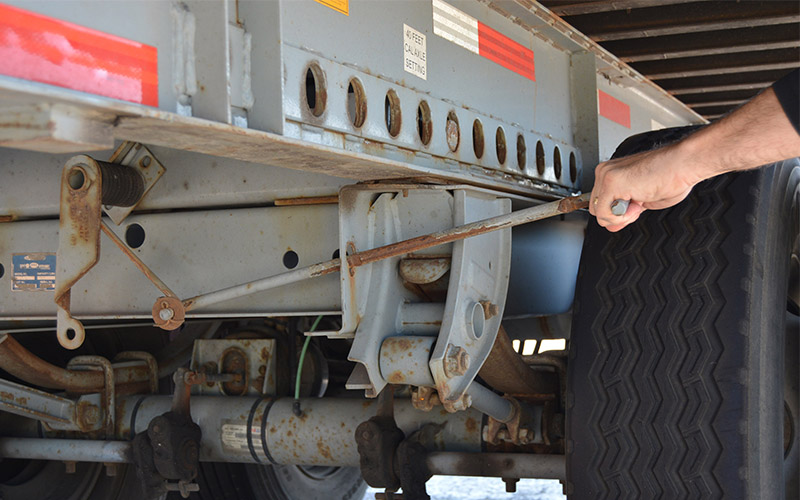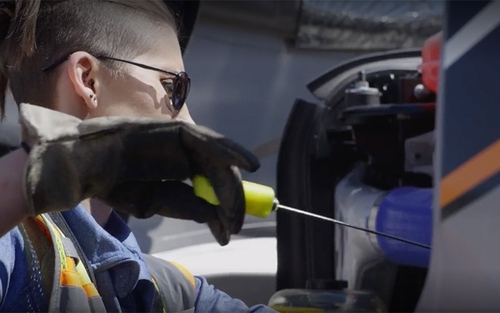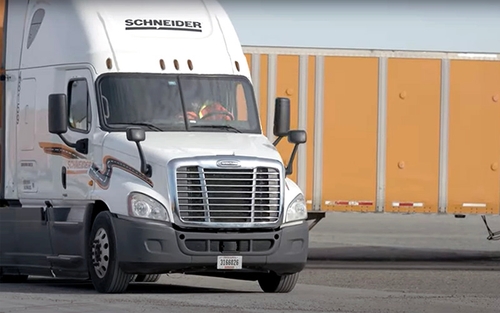Sliding tandems on a trailer: 16 simple steps to follow


By The Schneider Guy
Estimated reading time: 2 minutes
Knowing how to slide tandems on a semi-trailer and how to do it safely is an essential part of a truck driver’s job. Understanding the positions of the axles on a tractor-trailer is crucial, as they are a contributing factor as to whether a driver hauls a load safely and legally.
To learn all about sliding tandems on a trailer and how they work, check out our step-by-step guide and video demonstration below.
Watch: How to slide tandems on a semi-trailer
Read: How to slide tandems on a semi-trailer
Most tandem axles can be moved forward and backward along the length of a trailer to ensure proper weight distribution on the tractor and trailer axles. Many semi-trailers have sliding tandem axles that are mounted directly on the frame rails under the trailer.
16 basic steps to safely slide tandems forward:
- Ensure the tractor and trailer are straight and that the area in front of and to the rear of the unit is clear for sliding the tandems. Also ensure that the trailer is on a solid, level surface, as it can be difficult to slide tandems on gravel or snow-/ice-covered ground.
Set the parking brakes of the tractor and trailer.
Make sure the air pressure is at maximum.
Lock the power divider for maximum traction.
Activate the Trailer Hold Switch. This is also known as the Trailer Spring Brake Override Switch. If your tractor does not have this, you will use the trailer brake valve instead.
Pull the slider handle out (or up, depending on the trailer), then lock in the retainer. If facing difficulty while pulling this handle, consider using a tool for assistance or calling for help.
Mark the hole you want the front locking pin to land.
Shift the transmission into reverse. When operating a manual transmission truck, be sure the range selector is down, or Low-Side.
Release just the tractor parking brake by pushing on the yellow button.
Back the trailer up. The tandems will remain stationary while the trailer moves.
Set the tractor parking brakes and safely exit the tractor.
Check the position of the front locking pin.
If the pin is where you want it, remove the slider-locking handle from its retainer. Allow the handle to go in.
Shift into drive or reverse and rock the trailer gently to ensure the locking pins are firmly seated and completely through the holes.
Visually inspect that the pins are through the holes and the locking handle is all the way in.
- Unlock the power divider and deactivate the Trailer Hold Switch.
How to distribute weight on a tractor-trailer
When the weight of a load being hauled is unbalanced, a driver can transfer weight by sliding the tandems either backward or forward. When deciding which way to slide your tandems, remember to always slide toward the problem:
- If there is too much weight on the drive axles, slide the tandems forward so more weight is placed on the trailer axles. This is done by reversing while the tandems are unlocked.
- Likewise, if there is too much weight on the trailer axles, slide the tandems backward so more weight is placed on the drive axles. This is done by driving forward while the tandems are unlocked.
When sliding trailer tandems, ensure you do not slide them too far to the rear. Doing so could put you in violation of the Bridge Table Formula. To determine which setting you should use, look at your route and check the setting for each state you will drive in. Use the setting for the state with the most stringent (shortest distance from the kingpin) setting.
How much weight is moved when sliding tandems?
The amount of weight moved when sliding tandems depends on several factors, such as how the trailer is loaded and how much distance is between each hole.
In general, each tandem hole accounts for approximately 250 pounds of weight transfer. This means:
- If you move the tandems back by one hole, you transfer 250 pounds to the tractor axles.
- If you move the tandems forward by one hole, you add 250 pounds to the trailer.
Why truck drivers should know how to slide tandems
There are a few reasons why most truck drivers should know how to properly slide the tandems on a semi-trailer:
- To ensure the overall weight of their tractor-trailer is distributed in the best way possible.
- To meet the legal requirements of the states in which they drive.
- To follow regulations governing how far back or forward trailer tandems can be moved (also known as the distance between the kingpin on the trailer and the trailer’s tandem axle group).
Please note this is an example of how to slide tandems on a semi-trailer. It is important to remember the type of driver you are, the company you work for and the type of truck you drive can impact how you slide tandems on a semi-trailer. Be sure to consult your company guidelines or speak with your leader for more information about sliding tandems.
Discover more great driving tips and guides

Schneider Guy loves the "Big Orange." He's passionate about the trucking industry and connecting people to rewarding careers within it. He's been the eyes and ears of our company since our founding in 1935, and he's excited to interact with prospective and current Schneider associates through "A Slice of Orange."



